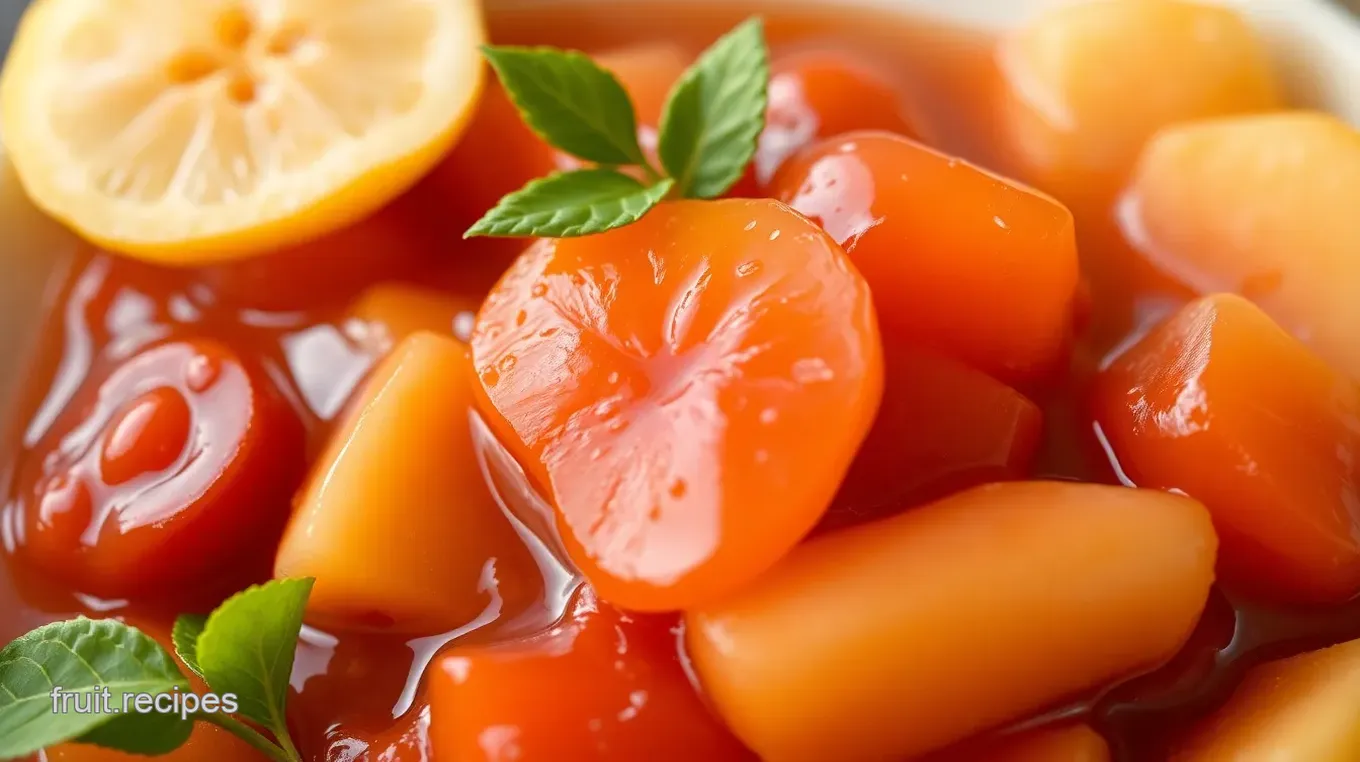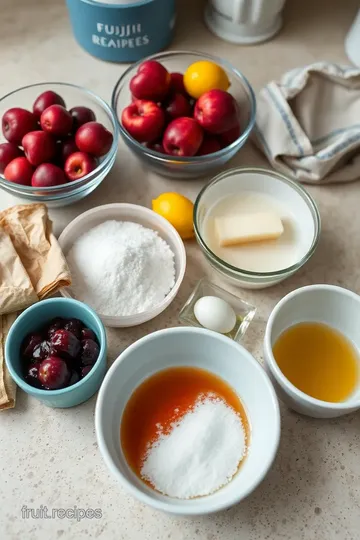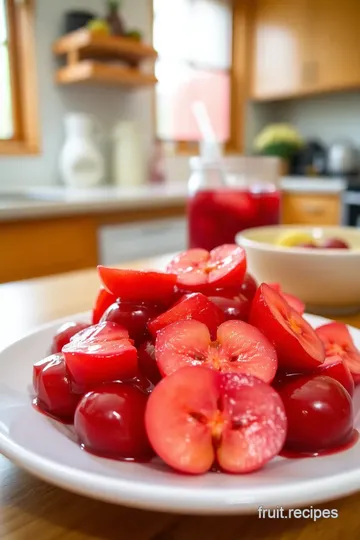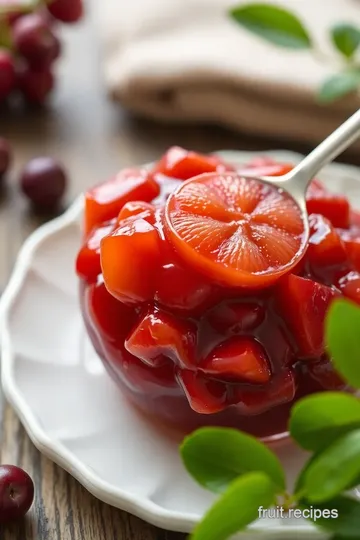Sweet Japanese Dogwood Fruit Jam
Discover how to Make Sweet Japanese Dogwood Fruit Jam with my easy recipe! Perfect for spreading, this jam blends sweet and tart flavors beautifully.

- Recipe Overview
- Key Benefits
- Your Essential Ingredients Guide to Making Sweet Japanese Dogwood Fruit Jam
- The Art of Professional Cooking: Mastering the Basics
- Pro Tips & Secrets
- Perfect Presentation
- Storage & Make-Ahead
- Creative Variations
- Complete Nutrition Guide
- Frequently Asked Questions
- Recipe Card
So, picture this: it’s a crisp fall afternoon, and i’m wandering through my yard, eyes peeled for that very special seasonal fruit—the japanese dogwood.
Seriously, if you’ve never had one, imagine a mix of sweet goodness and a hint of tartness dancing on your taste buds.
It’s like autumn in a bite! i distinctly remember the first time i decided to make sweet japanese dogwood fruit jam .
My kitchen turned into a whirlwind of delightful chaos. the aromas wafting through the air were just divine. honestly, it made my heart sing!
Now, you might be wondering, what’s the big deal about this fruit? well, besides being a unique gem found often in east asia, the japanese dogwood fruit has some fantastic health benefits too.
Packed with vitamins and antioxidants, it's a kitchen superstar! think about how amazing it would be to whip up some homemade fruit preserves that not only taste awesome but are good for you too.
Recipe Overview
Let’s take a little detour into history. the japanese dogwood fruit has roots that stretch all the way back to earlier cultures in east asia, where they harvested these little beauties for their sweet, succulent flavor.
Fast forward to today, and they’ve become quite the sensation in modern kitchens across the globe. making dogwood jam is not just a dying art; it's experiencing a real revival!
Now, let’s get down to brass tacks: time and difficulty . this jam-making project isn’t super quick, but don’t let that scare ya off! think about it—a solid 1 hour and 15 minutes from start to finish, but about 15 minutes of that is pure hands-on action.
I would say it’s a medium difficulty level—we’re talking about some jam-making techniques, like using pectin and canning. but hey, if you can make a sandwich, you can definitely do this!
In terms of cost, you’ll be pleased to know that making this jam is quite budget-friendly. for about $8-$10 , you’ll yield around 3 cups of this sweet magic .
Plus, it’s a nifty way to preserve seasonal flavors and keep the goodness of fall on your breakfast table year-round!
Key Benefits
Now, let’s chat about why this jam is a must-try. first off, the health benefits of the japanese dogwood fruit absolutely shine through in this spread.
It’s low in calories and high in flavor, which is a win-win for anyone looking to indulge without the guilt.
Who wouldn’t want that?
But that’s not all; this jam has a strong case as a unique gift idea. imagine gifting a jar of your very own homemade fruit preserves to a neighbor or friend.
It’s personal, thoughtful, and doesn’t break the bank! plus, it serves perfectly at brunches or holiday feasts, making it a versatile addition to your kitchen repertoire.
Let’s talk about flavor combinations ! you can get real creative here. spice it up with cinnamon, or even mix it with something like apples or pears for interesting dogwood jam variations.
It’s artistry, folks!
So, ready to dive in? Let’s gather our ingredients and get started on this delightful journey of preserving the unique essence of Japanese dogwood fruit. You won’t regret it!

Your Essential Ingredients Guide to Making Sweet Japanese Dogwood Fruit Jam
Alright, friends! let’s have a little chat about those essential ingredients you need to whip up a batch of sweet japanese dogwood fruit jam .
If you've ever thought about making your own jams, you're probably dreaming of those sweet and tart flavors dancing on your taste buds.
Plus, canning is like giving a hug to those seasonal fruits, preserving their glorious taste for later. let’s break it down!
Premium Core Components
First things first, let’s talk about the key ingredients for this jam. you’ll need 4 cups of ripe japanese dogwood fruit , about 500 grams .
For sweetness, you’ll grab 2 cups of granulated sugar (which is around 400 grams ) and 1/4 cup of bottled lemon juice (about 60 ml ) to brighten up those flavors.
Lastly, you’ll want 1 package of fruit pectin (about 1.75 oz or 49 g ) to get that jammy goodness going.
Storage guidelines? keep those dogwood fruits in the fridge. they only last about 5 days , and trust me, they’re best used ripe! as for your jam? if sealed correctly, it can sit pretty in a cool, dark place for up to a year .
Signature Seasoning Blend
Now, if you want to go beyond the basics, think about adding spices to your jam. a pinch of cinnamon or a dash of ginger can give you a delightful twist.
If you want to get adventurous, mix your dogwood fruit with apples for a fun twist.
Lastly, don't you forget about the lemon juice ! It’s not just there to taste good; it keeps the jam nice and bright.
Smart Substitutions
Let's say you can’t find japanese dogwood fruit (though i hope you will!). you can easily substitute with seasonal fruits like apricots or peaches.
They’ve got that sweetness and tartness too, and will work just fine.
What if you’re looking for a healthier sweetener? honey or maple syrup can work, but keep in mind that this might change how your jam sets.
Just remember: jam-making is all about finding flavors that make your heart sing!
Kitchen Equipment Essentials
Before you dive into this deliciousness, let’s get your kitchen prepped. most important? you’ll need a large pot to cook that fruit down.
A potato masher or food processor helps with mashing the dogwood fruit; you want that smooth puree.
Canning equipment essentials include sterilized glass jars —half-pint works best, and don’t forget those lids! Wipe down your jars before sealing them to avoid any tampering with the magic .
Honestly, remembering to sterilize jars and keeping them hot until your jam is ready is critical. Your jam can last longer if you've sealed those jars right!
How to Make Dogwood Jam
Now that we’re all set with the right ingredients and tools, i can’t wait to share the juicy details on how to make dogwood jam .
If you are well-prepped, the process feels like a breeze and honestly—so worth it when you have that sweet and tart fruit spread ready to slather on warm toast or hand out as homemade gifts from the kitchen !
You’ll get to enjoy those japanese dogwood fruit benefits , full of flavor and nutrients, and your taste buds will thank you! think about the joy of family breakfast with your homemade jam shining on the table.
That’s the spirit of preserving those seasonal flavors.
So buckle up, dear friends! Your journey into the world of fruit-based breakfast spreads is only just beginning. Next up, let's throw on our aprons and jump into some easy jam recipe instructions!

The Art of Professional Cooking: Mastering the Basics
When it comes to cooking, whether you're whipping up a casual weeknight dinner or diving into something a little fancier, nailing down a professional cooking method is key.
This method not only amps up your dish's quality but also saves you from the typical kitchen chaos. let's break down the essential prep steps, step-by-step processes, expert techniques, and success strategies.
Essential Preparation Steps
First things first: mise en place . this fancy french term just means "everything in its place." before you fire up the stove, measure your ingredients, and have them ready to go.
This will save you so much time and stress later on, trust me. there’s nothing worse than realizing you’re out of sugar right when you're about to add it to your mix!
Time management tips? it's all about knowing what takes longer. start with items that take a while to cook, like a pot roast, and use that time to prep smaller items.
And organization? use small bowls or containers for your ingredients. it’s like a little kitchen organization party!
Now, let’s talk safety. always keep a clean workspace. knife safety is critical; cut away from yourself and keep fingers out of the way.
And, hey, don’t forget to wash your hands often. you want your food delicious, not dangerous!
Step-by-Step Process
Alright, here’s how to tackle a recipe in easy steps. Grab your ingredients and follow this numbered guide .
- Gather your ingredients.
- Preheat the oven or stove to the right temperature. This is usually about 350° F for most baked goods.
- Into a large pot or pan, start combining your ingredients . Think of this as a warm-up for what’s to come.
- Cook at the correct temperature! If a recipe says simmer , aim for a gentle bubble, not a full-on rolling boil.
And don’t forget timing! each recipe will give you a timeline—stick to it. when baking, even an extra minute can mess things up.
You want that perfect golden edge. keep an eye on those visual cues ; dough should spring back, meats should be browned, and cakes should bounce back when you touch them.
Expert Techniques
Want to take your cooking up a notch? try experimenting with professional methods . for instance, master the sear! get your pan hot, and those proteins will develop that great crust.
It’s a game-changer when you’re cooking meats.
Quality checkpoints are super important, too. That just means tasting your food as you go along. You’ll slowly develop the ability to adjust spices and flavors as you cook.
And if something goes awry? here’s a troubleshooting tip : if your sauce is too thin, let it reduce longer.
If it’s too salty, toss in sugar or unsalted ingredients to balance it out. cooking is a journey, and you’ll hit bumps.
Don’t sweat it!
Success Strategies
Ever burned the toast or dropped half your ingredients? Yeah, I’ve been there. Here are some easy strategies to keep you on track:
-
Avoiding common mistakes: Read the whole recipe before starting. Trust me, it saves you from a lot of flipping back and forth in the middle of cooking.
-
Quality assurance: Always use fresh ingredients. Old spices or sad veggies can ruin a dish.
-
Want perfect results ? Invest in a good thermometer. They are a lifesaver, especially when cooking meats that need specific internal temperatures.
-
For make-ahead options, jam is a classic! make sweet japanese dogwood fruit jam on a sunday to pair with breakfast all week.
It lasts in the fridge, and you can easily alter it to add your favorite spices.
So, what's the takeaway here? cooking, much like crafting the perfect jam, requires a mix of preparation, technique, and love.
You’ll find your rhythm, just like with those sweet homemade fruit preserves we all adore.
And just like our delicious dogwood jam, we’ll be diving into additional information later on, with more tips and tricks to keep your culinary explorations fresh and flavorful!

Pro Tips & Secrets
When you venture into the world of jam-making , every little trick counts. So, how do you tackle the process with finesse? Here are some insider secrets that will make you say, “Wow, why didn’t I think of that?”
First up, select ripe fruit . for your sweet japanese dogwood fruit jam, make sure those little gems are perfectly ripe.
Trust me, you want that natural sweetness to shine through. as i learned the hard way, unripe fruit can lead to a jam that feels more like a sour candy—definitely not the vibe we’re going for!
For a real time-saver, you can prep your dogwood fruit in advance . mash it the night before and throw it in the fridge.
When you’re ready to make jam, just pull it out and get cooking. easy peasy!
And let’s not forget about flavor enhancement. a splash of lemon juice isn’t just for show ; it’s crucial for the taste and helps the pectin do its thing.
Plus, it adds a delightful zing!
Once you’ve cooked your jam, taking a moment to taste and tweak is key. if it’s a touch too sweet, add more lemon juice.
If you want to kick it up a notch, some ground ginger or a sprinkle of cinnamon can bring in fantastic notes.
Play around!
Perfect Presentation
Now, we all know that we eat with our eyes first, right? So when you finally make that Sweet Japanese Dogwood Fruit Jam , how do you make it pop?
Let's talk plating techniques . You can go simple with a clean glass jar, but why not jazz it up with a cute fabric cover on the lid or a pretty ribbon around the jar? A little touch makes it an instant homemade gift five stars !
For a garnish, consider a thin slice of lemon or some fresh mint leaves. It’s an easy way to add color and make it look super fresh.
When you’re thinking about color combinations , throw in some colorful toast or a vibrant cheese board. you want those vibrant pinkish-red tones popping against the backdrop of your serving dishes.
It really elevates your jam to look like an artisan spread .
Storage & Make-Ahead
Now, let’s talk storage . after making your jam, you’ll want to store it safely. if you follow the canning steps right, your jam should last about a year on the shelf.
Just keep those jars in a cool, dark place (not the back of your cupboard, please!).
If you’re prepping for later, you can make this jam up to a month ahead. To ensure freshness duration , always check the seals on your jars and look for any funky smells or bubbling—those are bad signs!
When it comes time to reheat ? Just pop that jar open, and if you're mixing it into some yogurt or oatmeal, no need to heat at all!
Creative Variations
There’s no reason to stop at the classic recipe! Let’s dive into some creative variations that will keep your taste buds dancing.
How about a spicy twist ? add in some chili flakes for a surprising kick. or if you're feeling like a true artist, combine the dogwood fruit with other seasonal fruits like peaches for a yummy blend that surprises everyone at breakfast.
If you’re looking for dietary modifications, you can swap out the sugar for honey or even work with alternative sweeteners.
Just be mindful, as this may affect how well your jam sets up!
And for those adventurous spirits out there, consider making a dogwood jam variation with different herbs or spices. Rosemary or thyme can add flavors you wouldn’t expect—but they work, trust me!
Complete Nutrition Guide
When you’re making sweet japanese dogwood fruit jam , it’s good to know what’s going on nutritionally. each tablespoon is about 50 calories, and it’s a sweet way to get a bit of fruit into your diet.
Plus, think about the health benefits of these fruits ! japanese dogwood fruit is packed with vitamins and antioxidants. if you’re looking to boost your mornings or afternoon snacks, this jam always does the trick.
Just remember, moderation is key. While those sweet fruit spreads are delicious, one or two tablespoons hit the spot without going overboard.
So there you have it! A full guide on how to Make Sweet Japanese Dogwood Fruit Jam along with some secrets, presentation tips, and storage wisdom.
Look into in, have fun, and don’t be afraid to make it your own. whether it’s for a gift or for yourself, this jam is just waiting to fill your kitchen with deliciousness and that sweet, sweet feeling of homemade goodness.
Happy jamming!
Frequently Asked Questions
What is the best way to make Sweet Japanese Dogwood Fruit Jam?
To make Sweet Japanese Dogwood Fruit Jam, start by mashing ripe dogwood fruit and combining it with sugar and lemon juice in a pot. Cook until the sugar dissolves, then add pectin and boil until it reaches the right consistency. Follow proper canning techniques to properly store and preserve your jam.
Can I substitute other fruits if I can't find Japanese dogwood fruit?
Yes, if you can't find dogwood fruit, you can substitute other seasonal fruits such as apricots or peaches. Keep in mind that different fruits may alter the flavor profile and set of the jam, so you might need to adjust the sugar and pectin accordingly.
How do I store Sweet Japanese Dogwood Fruit Jam after making it?
After making the jam, it's important to process the jars in boiling water for safe canning. Once sealed, store the jars in a cool, dark place, and they can last up to a year. After opening, keep the jam refrigerated and consume it within a few weeks.
What are some tips for achieving the perfect jam consistency?
To achieve the perfect consistency for your jam, ensure you boil the mixture long enough after adding pectin, and always perform a gel test by spooning a small amount onto a cold plate. It should wrinkle when pushed with your finger once it's done. If it’s too runny, you can cook it a bit longer to help it set.
Are there any nutritional considerations for Sweet Japanese Dogwood Fruit Jam?
Per serving, Sweet Japanese Dogwood Fruit Jam has about 50 calories and is primarily made up of carbohydrates. While it contains sugar, it also provides a delightful way to enjoy the unique flavors of the japanese dogwood fruit, so moderation is key, especially for those monitoring sugar intake.
Can I add spices or other flavors to my dogwood fruit jam?
Absolutely! You can enhance the flavor of your jam by adding spices such as cinnamon or ginger. Additionally, ingredients like vanilla extract or orange zest can create interesting flavor twists that complement the dogwood fruit's natural sweetness.
Sweet Japanese Dogwood Fruit Jam Card

⚖️ Ingredients:
- 4 cups ripe Japanese dogwood fruit, mashed (approximately 500 g)
- 2 cups granulated sugar (400 g)
- 1/4 cup bottled lemon juice (60 ml)
- 1 package (1.75 oz/49 g) fruit pectin (e.g., powdered pectin)
- 3 sterilized half-pint glass jars with lids
- Water for boiling
🥄 Instructions:
- Step 1: Rinse and mash the dogwood fruit until you have a coarse puree.
- Step 2: In a large pot, mix the fruit puree, sugar, and lemon juice.
- Step 3: Stir the mixture over medium heat until the sugar dissolves.
- Step 4: Bring to a rolling boil, then add the pectin, stirring continuously.
- Step 5: Boil for 10-15 minutes, then conduct a gel test using a spoon or a candy thermometer (should reach 220°F or 104°C).
- Step 6: While the jam boils, prepare the canning jars by placing them in boiling water to sterilize.
- Step 7: Using a ladle, fill the sterilized jars with the hot jam, leaving about 1/4 inch of headspace.
- Step 8: Wipe the jar rims clean, place the lids on, and screw on the rings until snug.
- Step 9: Process the jars in boiling water for 5-10 minutes to ensure a proper seal.
- Step 10: Allow the jars to cool completely on a clean towel, and check seals before storing.
Previous Recipe: Easy Bake Fruit Torte Cake: A Refreshing Delight for Your Gatherings!
Next Recipe: Delightful Bake Japanese Fruit Pie - Deliciously Sweet: A Family Favorite
